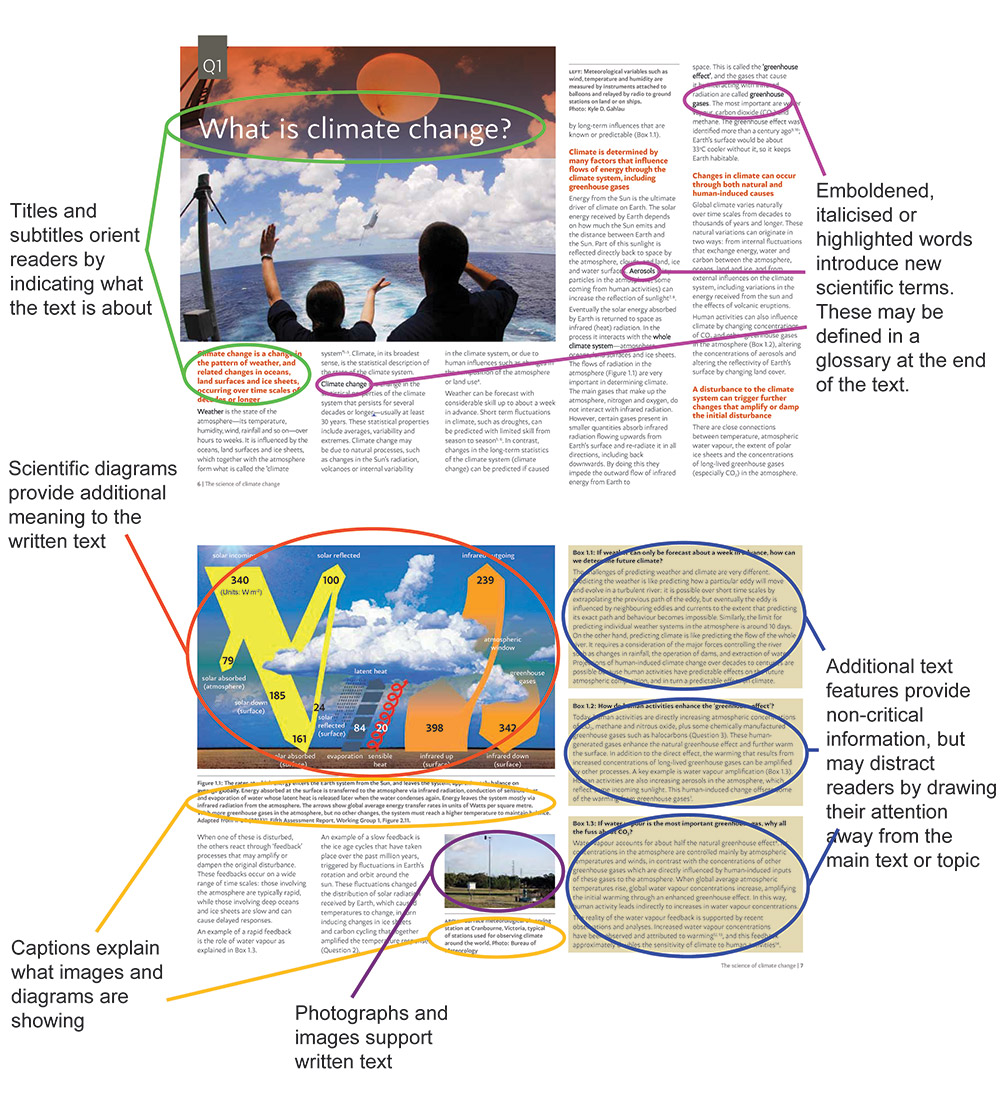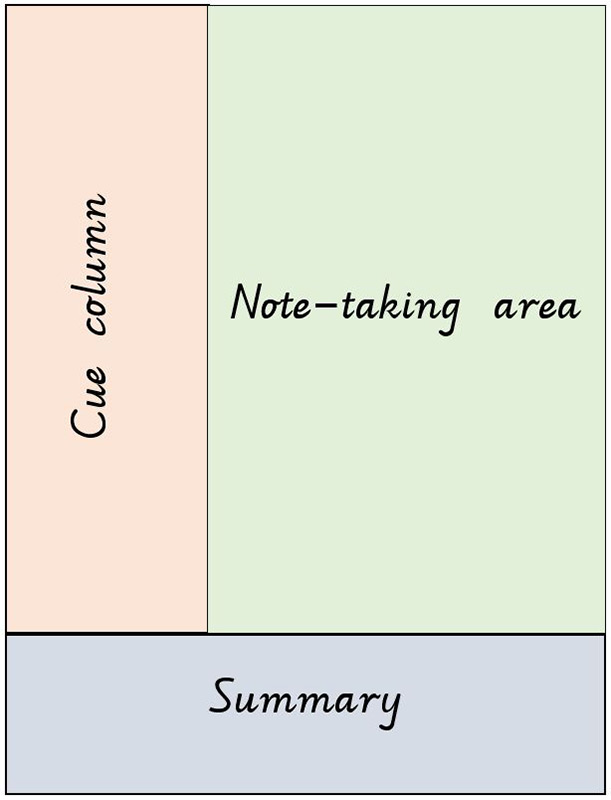In Science, students read for a variety of reasons, including to:
- develop understanding
- assess experimental method
- identify and evaluate evidence
- determine validity.
No matter their purpose for reading, students need to adopt an objective position, asking questions as they read. The types of questions they ask, though, depends on the purpose of their reading.
Providing students with a purpose before their reading will help to focus their reading to identify, select and understand particular content in a written text.
In addition to varied reading purposes, another challenge for students reading in Science is text complexity. Traditionally, texts in science are complex. They:
- introduce students to a range of new vocabulary
- have high lexical density (many words that carry content such as nouns or verbs)
- explain abstract concepts and processes
- require the reader to move between text and images to develop meaning.
Scientific texts are often multimodal, containing images, diagrams and graphs. Students must learn to read and interpret visual and non-text-based representations of complex or abstract concepts, ideas and processes.
In the Science classroom, students also read a range of texts to develop their scientific understanding. These include but are not limited to:
- science textbooks
- scientific reports
- newspaper articles
- material on websites.
Each of these types of texts vary in language use, density, sophistication, and degree of multimodality. The different text types also have different functions, and so students must adopt different reading positions when accessing them.
Providing a range of reading strategies and scaffolds to support students to read and interpret texts in Science will not only assist them to develop their scientific understanding, but also to become independent learners.
Reading in Science should be both an active and interactive process.
Reading is
active when students use pre-reading, during reading, and after reading strategies to check their understanding of a text.
Reading is
interactive when students use a range of available resources, such as prior knowledge, other people and other texts, to make sense of a text (Gee, 2000; Valencia & Pearson, 1987).
Teaching strategies
The teaching strategies outlined below are designed to develop students’ literacy to read the kinds of texts they will encounter in Science. Versions of them can also be found in the
Primary Literacy Teaching Toolkit.
Strategies that teachers can use to support students to read texts include:
Explicitly teaching text structure
A simple strategy to begin supporting students to develop literacy within Science is to explicitly teach them about text structure, organisation and visual supports.
Scientific texts:
- are often chronologically ordered
- describe causal effects
- use headings to organise and categorise sections of text
- include images and diagrams that support and add meaning to written language.
Explicitly teaching students about these common textual features will help them to better understand how to interpret and access information in written scientific texts. These text features can be used to generate pre-reading questions (see
Generating text-dependent questions).

View full size 'What is climate change' image - jpg 900kb
Source:
The science of climate change: Questions and answers, Australian Academy of Science, Canberra, 2015.
Generating text-dependent questions
Using text-dependent questions is:
- an instructional practice or approach where readers are provided with questions prior to reading a text
- a guided reading strategy, as it provides support for students before, during and after reading, and
- a close reading activity, as students reread text to extract meaning and find evidence.
Student-generated questions
Pre-reading
- Instruct students to highlight noticeable text features (e.g. headings, images, captions, special print).
- Ask students to predict about what the text is informing them.
- Individually or as a class, convert textual features into questions.
- Heading is “Meiosis” and sub-heading is “Independent assortment”; student-generated questions are “What is meiosis?” and “Why is independent assortment important?” (Year 9 or 10,
VCSSU119)
- Diagram shows Newton’s 2nd Law; student-generated question is “When does Newton’s 2nd Law apply?” (Year 9 and 10,
VCSSU133)
During reading
- Students focus their reading of the text to answer the questions they have generated.
After reading
- Students discuss answers to their questions, with teacher clarifying any misconceptions or ambiguities.
- Students write down answers to their questions/a selection of the questions.
This activity can be modified to have students annotate the texts as they read and find answers to their questions.
Teacher-generated questions
Prior to the lesson
- The teacher lists the main concepts students are to learn from the reading.
- The teacher creates 4–6 statements that are supported or challenged by the reading. For example, if students are reading a text about energy flow in ecosystems in Year 9 or 10 (VCSSU121), the focus statements might be:
- Food chains and food webs show the movement of energy in an ecosystem
- Available energy increases as you move up a food chain
- First-order consumers are the top level predators
- Decomposers provide energy to producers.
During the lesson
Pre-reading
- Students read the teacher-generated statements, noting down whether they agree or disagree with each one.
During reading
- Students read the text, searching for evidence that either supports or refutes each statement.
After reading
- In pairs, students review and, where necessary, revise their decisions regarding each statement.
- As a class, discuss what was learned from reading.
- Students write down true statements and rewrite false statements to make them true.
Using graphic organisers
Graphic organisers are visual models that can be used in a number of ways to support student learning, including to show relationships (for example, concept map), to compare and contrast similarities and differences (for example, Venn diagram), to show hierarchical relationships (for example, pyramid).
Graphic organisers can be used to set purposes for reading, thereby helping to focus student reading and to assist their comprehension.
The Cornell note-taking system (Pauk & Owens, 2010) is one type of graphic organiser that teachers can teach their students to use to support reading comprehension (Evans & Shivley, 2019). This note-taking system can also be used to support students to develop scientific understanding, whether when reading texts or listening to a read-aloud.
The Cornell note-taking system
Before reading, students divide a page into three unequal sections as shown below.

While reading (or listening to a speaker), the student writes ideas and concepts from the reading into the note-taking section.
After reading, the student:
- Reviews and clarifies notes, correcting any spelling mistakes
- Writes questions about the main ideas in the cue column
- Covers the notes and answers the questions they have written
- Writes a 1-2 sentence summary in the summary section.